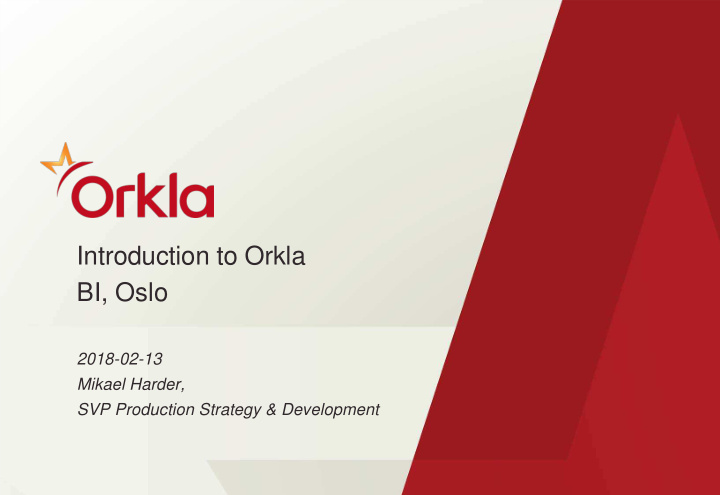



1 Introduction to Orkla BI, Oslo 2018-02-13 Mikael Harder, SVP Production Strategy & Development
My personal 7-step program 1 5 7 4 6 2 3 2
Orkla in numbers The Leading Nordic supplier of branded consumer goods OPERATING MARKET VALUE 2 REVENUES 1 EBIT (ADJ.) 1 NOK BILLION 40 4.6 87 8.5 MILLION 18,178 EMPLOYEES 2 CONSUMER UNITS SOLD DAILY 3 1 2017 2 As of 31 December 2017
As the leading Nordic supplier of branded consumer goods (BCG) Orkla aspires to be «Your friend in everyday life» Our business idea: Improving everyday life with healthier and more enjoyable local brands 4
Transition from conglomerate to leading Branded Consumer Goods company – how did we get here? 2 1 3 1986 – 2003 2004 – 2010 2011 – 2016 Consolidating Norwegian and Nordic BCG Industry Broader focus Strategy to focus on BCG 65 Acquisitions: 1986 – 1991: Consolidating the Norwegian BCG sector (2012) (2016) 60 (2012) (2016) 55 (2015) D(2016) 1994 – 1997: Consolidating the Nordic BCG sector (2015) (2016) 50 (2016) (2016) 45 (2016) 2000: Establishing Carlsberg Breweries (40% ownership) 40 NOK billion Divestments : 35 2001: Acquisition of Berlingske Elkem (2011) Borregaard Skoger (2010) 30 REC (2013) 25 Borregaard (2013) Orkla Brands Russia (2014) 20 Acquisitions : Asan (2016) Elkem (2005) 15 Sapa (2005) IPO’s : 10 Divestments : Borregaard (2012) Stake in Carlsberg Breweries (2004) 5 Gränges (2014) Orkla Media (2006) 0 Establishment of joint 1986 1988 1990 1992 1994 1996 1998 2000 2002 2004 2006 2008 2010 2012 2014 2016 ventures : Sapa JV (2013) Revenues BCG Revenues from industrial activities
Orkla’s Business areas represent many categories… Orkla Orkla Orkla Orkla Orkla Food Confectionery & Foods Care Investments Snacks Ingredients (42.5%) Hydro Power Financial Investments Orkla Venture Corporate Centre and Group Functions 6
…with a strong presence in the central and Nordic European markets and continued growth in other parts of the world 7% 31% 22% 10% 5%Re 4% Baltics: 5% Rest of Europe: 20% Significant operations *FY 2015 adjusted for acquisition of Hamé and Cederroth >100 mill NO revenue
Orkla has outperformed peers and OBX the last three years Orkla ASA vs. Peers Indexed Price Performance Price (Indexed to 100) 180 Orkla OBX Peer group 62.17% 160 41.71% 140 120 18.08% 100 80 60 10.14 1.15 4.15 7.15 10.15 1.16 4.16 7.16 10.16 1.17 4.17 7.17 Source: FactSet Prices Peer group consists of P&G, Unilever, Colgate Palmolive, Reckitt Benckiser, Henkel, Nestlé and Mondelez
Orkla’ s business model – how do we stand out? Market proximity and product Local tailoring Optimised Utilising market proximity Extracting synergies across categories and markets Multinational Synergies
Orkla Supply Chain- an arena for further improvements 8.5 98 3.6 million percent times/year DELIVERED ON TIME CONSUMER UNITS INVENTORY PRODUCED DAILY TURNOVER SUPPLY CHAIN COST BASE FACTORIES EMPLOYEES (NOK BILLION) ~11000 104 ~27 10 As of 31 December 2017
OUR PROGRESS IN BRIEF We have strengthened our competitive position by increasing efficiency and lowering costs 1 Rationalise • The footprint programme is progressing at a 7-8 historically high pace across all business areas manufacturing & warehouse Factory closures • Revenue per factory increasing (40+%) despite high per year structure pace in acquisitions 2 • Intensified focus on factory performance improvement 15% projects – 39 projects initiated Continuous cost improvements Turnaround • Track record of ~15% improvements on addressable achievement cost base on completed turnarounds 3 >25% • Centralisation of procurement enables leverage as Accelerate “One Orkla” to take out significant cost purchasing Reduction in no. of savings • Leap forward in responsible sourcing suppliers by 2018 4 • Step change in digitalised performance management 20-30% and build up of Centres of Excellence Strengthen Reduced capabilities • Ahead of plan in reducing environmental impact environmental impact • Supply chain orchestration to optimise working capital 11
Making our supply chain a competitive advantage for Orkla 1 Being the preferred Rationalise manufacturing supply chain partner for & warehouse structure our customers 2 Continuous cost improvements End to end cost competitiveness and 3 Accelerate optimised capital utilisation purchasing savings 4 Increased innovation speed Strengthen capabilities and ability 12
Recommend
More recommend